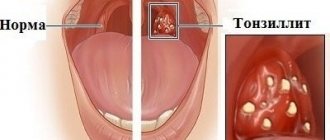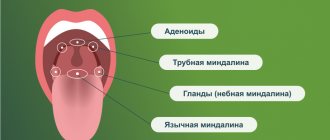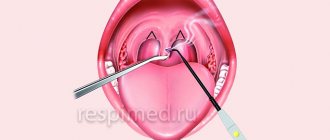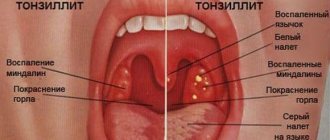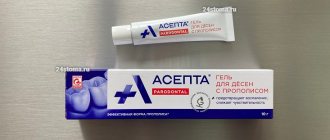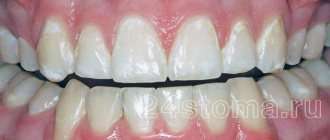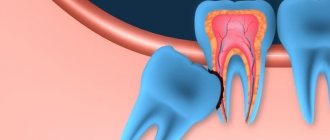Tonsillitis is an infectious disease in which inflammation of the tonsils (glands) occurs. This disease affects both adults and children aged 2 years and older. Tonsillitis in a child most often occurs between the ages of five and ten years, and inflammation can recur several times a year.
The acute form of the disease is nothing more than the well-known sore throat. A person who has suffered from a sore throat at least once, during which he experienced severe pain in the throat, will not confuse it with any other diagnosis. Sore throat is an insidious disease that can cause serious complications in related organs and even lead to disability. What effective measures should be taken in the treatment of inflammation of the tonsils to avoid complications? We will talk about this in detail in our article.
Tonsils on guard
The tonsils (or tonsils) are located on both sides of the throat. All bacteria and viruses that enter the body through the mouth are encountered first. Externally, the tonsils have a porous structure; this structure helps them “examine” all the substances that enter the body and decide what to do with them. In the thickness of the palatine tonsils there are special depressions - lacunae, and the convoluted channels in the thickness of the tonsils are called crypts; they are difficult to see in a photo or with the naked eye. There are also target cells that act as “traps” for microorganisms. When it comes into contact with them, the tonsil decides whether to fight them or not, whether they will cause harm to a person or whether they will be harmless.
When a person is healthy and his tonsils are strong, when any infection enters the body, they begin to actively produce white blood cells to fight the infectious pathogen. But when inflammation affects the tonsils themselves, they lose their protective function and themselves become a source of infection. Pathogenic viruses and bacteria settle firmly in the gaps. What function can inflamed tonsils perform? None! As a result, the tonsils fall out of the body's general defense system and there is a high chance of developing chronic tonsillitis in children.
Causes of tonsillitis
As a rule, the cause of the disease is bacteria and viruses (usually streptococcus). Typically, infection occurs through airborne droplets, especially when children are in large groups (kindergarten, school, various clubs and sports sections). If the causative agent of the disease is bacteria, you can become infected through dishes, a handshake, or through the patient’s personal items (towel, spoon). A child only needs to play with the toys of another sick child to become infected. Alas, acute tonsillitis is a highly contagious disease; and it is very easy to become infected with it.
Another cause of the disease is microorganisms that constantly live on the mucous membranes. This is the norm. A healthy body controls their amount and does not allow them to be exceeded. But as soon as the immune system weakens, the number of pathogenic microorganisms begins to increase: and in essence it turns out that the body infects itself. That is, the development of inflammation can occur with prolonged exposure to unfavorable factors on the child’s body that cause a decrease in immunity: dry indoor air, cigarette smoke, polluted air in big cities, etc.
Causes of sore throat in children
The disease is more common in school-age children and teenagers2. Sore throat in a child under 2 years of age is rare and is caused by insufficient development of the lymphoid tissue of the pharynx2.
In the vast majority of cases, tonsillitis develops as an infectious process2.
- Primary (banal) it can be caused by:
- beta-hemalytic streptococcus A;
- streptococci C G;
- staphylococci, pneumococci and other bacteria;
- viruses: respiratory parainfluenza viruses, adenoviruses, coronaviruses, respiratory syncytial viruses, roto- and enteroviruses, Coxsackie viruses, herpeviruses, etc.2
- Secondary inflammation can develop:
- for childhood infections (measles, rubella, scarlet fever);
- for syphilis, tuberculosis;
- as one of the symptoms of leukemia or agranulocytosis2.
The high susceptibility of children to viruses and streptococcus causes the widespread prevalence of tonsillitis. The source of infection is always a person – a patient or a carrier of the pathogen.
In the case of viral processes, these are patients with ARVI, measles, rubella, etc., in the case of catarrhal or purulent tonsillitis caused by streptococci, these are patients with tonsillitis.
The route of transmission of pathogens is airborne droplets or contact. Microbes are transferred from the patient into the environment along with sputum when sneezing and coughing. They are introduced into the body of a healthy baby with dirty hands, when using shared dishes, household items and hygiene items, during close contact, for example, when kissing.
The development of tonsillitis is promoted1,2:
- hypothermia, which often happens in the autumn-winter period and early spring;
- overwork, in particular excessive loads associated with training, attending numerous clubs and studios;
- unbalanced diet - predominance of carbohydrate foods in the diet, lack of vegetables and fruits rich in vitamins and essential microelements,
- the presence in the body of a focus of chronic infection (runny nose, sinusitis, caries, otitis media and others);
- decreased immunity after acute respiratory viral infections and other diseases suffered the day before;
- primary immunodeficiency.
Up to contents
Symptoms of the disease in children
The first symptoms in children suffering from acute tonsillitis appear already on the first to third days after infection, among them:
- high body temperature (with fever, the temperature may rise to 40°C);
- severe pain in the throat, it is very difficult and painful for the child to swallow;
- the tonsils increase in size and turn red; pustules may be noticeable on them;
- headache;
- sick children lose their appetite;
- weakness, lethargy;
- enlarged lymph nodes;
- gastrointestinal tract disorders are possible;
- bad breath.
In children with chronic tonsillitis, the symptoms are not as pronounced. The body temperature remains at the subfebrile level for a long time (37-37.5°C). The tonsils become loose - a sign that they have lost their protective function.
Hypertrophy of the palatine tonsils in children
The growth of the palatine tonsils most often occurs in childhood - during the period of active tissue construction and adaptation of the body to its environment. As the body ages, the tonsils gradually decrease in size.
There are cases when the tonsils are enlarged from birth. But most often, their intensive growth serves as a response to increased inflammation of both the tonsils themselves (called tonsillitis or tonsillitis) and neighboring organs. Inflammation develops when:
- frequent infectious diseases;
- allergies;
- irritation of the mucous membrane by chemical or thermal factors.
The tonsils are located on the sides of the pharynx. If they increase slightly, the child does not experience any discomfort (hypertrophy of the tonsils and their inflammation are not the same thing) and does not need treatment. Moreover, with the onset of puberty, their reverse development begins. If they reach a large size and block the lumen of the pharynx, then characteristic signs appear:
- difficulty breathing (especially with a combined enlargement of the nasopharyngeal tonsil - adenoids);
- violation of diction;
- problems swallowing food;
- night cough;
- the child may snore and wake up frequently, and a chronically sleep-deprived baby will behave restlessly during the day.
Complications
It may seem that acute tonsillitis is a completely harmless disease. “Sore throat, fever - what’s wrong with that? A common manifestation of infection,” you say. But let us remember the nature of the disease. Its causative agent, streptococcus, can cause serious consequences.
Complications after tonsillitis can be divided into local (they are localized and noticeable in a certain area) and general (when changes affect the whole body).
Local ones include:
- paratonsillar and parapharyngeal abscess;
- mediastinitis (when a purulent infection descends into the heart sac);
- bleeding from the tonsils, provided that there were ulcers on their surface;
- otitis and eustacheitis (ENT organs are directly connected to each other, so an infection from the throat can easily migrate to the middle ear cavity, the auditory tube and cause an inflammatory process there);
- swelling of the larynx (with this condition, asphyxia develops. This condition is very dangerous, even fatal. A characteristic sign is a bluish tint of the skin against the background of severe suffocation);
- phlegmon and abscesses (purulent inflammation).
Common complications include diseases of the heart, kidneys, joints (rheumatism), tonsil intoxication and sepsis. In order to avoid dangerous consequences for the child’s body, it is very important to promptly begin the fight against tonsillitis under the supervision of a qualified otolaryngologist.
Friends! Timely and correct treatment will ensure you a speedy recovery!
Make an appointment right now!
Call us by phone or use the feedback form
Sign up
Treatment of sore throat in children
Mild forms of the disease can be managed at home, under the supervision of a local doctor3. An exception is sore throats in children under one year of age: they need to be treated only in a hospital3.
Moderate and severe tonsillitis at any age is an indication for hospitalization, as are any forms of inflammation in children with immunodeficiencies, developmental defects and diseases of the nervous system3.
Mode
In the first 3-4 days of illness, bed rest is indicated2.
Diet
The diet is gentle, with a predominance of dairy and vegetable dishes, limiting salt, sugar, and excluding spices and herbs.
Drink plenty of fluids
It prevents dehydration due to fluid loss during fever and helps reduce symptoms of intoxication.
Antibacterial and antiviral therapy
Bacterial inflammation requires treatment with antibacterial drugs in the form of tablets, injections or intravenous infusions - it is prescribed by a doctor. Regardless of how long the temperature lasts, if a child has a sore throat, the duration of treatment with antibiotics is at least 10 days2,3.
It makes no sense to give your baby antiviral drugs, since respiratory viruses, which most often cause tonsillitis, are practically insensitive to them1. In addition, viral forms of the disease are mild1,2.
Antipyretic drugs
WHO recommends the use of antipyretic drugs in previously healthy children only if the temperature rises above 390 C, and if heat is poorly tolerated: headache, aching muscles and joints2. For babies under one year of age, as well as children prone to seizures, fever medicine should be given earlier - as soon as the temperature reaches 380 C.
In other cases, you need to use physical methods to combat the fever: light clothing, a fan, rubbing, cold compresses on the forehead, armpits and groin area2.
Local treatment
It includes gargling with special solutions, irrigating the tonsils, and sucking special tablets containing antiseptic, anti-inflammatory and analgesic components.
To gargle with a sore throat, children from the age of three can use HEXORAL® SOLUTION for gargling based on hexethidine5. Hexetidine is active against bacteria, including beta-hemolytic streptococcus, respiratory viruses and fungi, and has a mild analgesic effect, so it can be used as an adjunct to the main treatment of tonsillitis5.
HEXORAL® SOLUTION is not suitable for children who, due to age and lack of skill, simply do not know how to gargle. For such cases, there is HEXORAL® in the form of an AEROSOL, which is evenly sprayed over the entire surface of the pharyngeal mucosa and provides the necessary therapeutic effect6.
For a 4-year-old child, HEXORAL® TABS7 is suitable, and for sore throat in a child 6 years of age and older, HEXORAL® TABS CLASSIC8. HEXORAL® TABS7 contains, in addition to the antiseptic component, the local anesthetic benzocaine, which helps fight sore throat and facilitate swallowing7,8. The composition of HEXORAL® TABS CLASSIC8 includes two antiseptic components, amylmetacresol and dichlorobenzyl alcohol, which enhance the antiseptic effect of each other. The pleasant orange, lemon, honey-lemon, and blackcurrant taste of the tablets is usually liked by children and encourages them to undergo treatment8.
HEXORAL® TABS EXTRA is intended for children over 12 years of age9. It contains lidocaine, a powerful pain reliever that helps fight even the most severe sore throat9.
Please note that after using the drugs, the patient should not be allowed to eat or drink for half an hour.
Up to contents
How to cure tonsillitis in a child
Treatment methods for sore throat depend on the nature of the pathogen: for bacterial sore throat, the doctor will prescribe effective antibiotics (the drugs Augmentin, Amoxiclav, Erythromycin are more often prescribed), for sore throats of a viral and fungal nature - anti-inflammatory and antifungal drugs, respectively. The name of the drug, its dosage and the duration of its use can only be determined by an ENT doctor. Excessive parental independence can interfere with the effective treatment of acute or chronic tonsillitis.
If a child's temperature rises above 38°C, an antipyretic based on ibuprofen or paracetamol should be given. Due to blood thinning and the risk of bleeding, aspirin is strictly contraindicated in children.
It is necessary to adhere to strict bed rest and a gentle diet. Eating and drinking should not cause additional strain on the throat. It’s better to make do with warm soups, broths and purees for the first time. Oral antiseptic sprays, special lozenges and tablets (for example, Faringosept) are perfect for relieving a sore throat.
Drug treatment, do you need an antibiotic?
Treatment of tonsillitis in a child should be comprehensive!
To treat tonsillitis in a child, the following groups of medications are used:
- Antiseptics. These include special solutions for rinsing and treating the inflammatory focus, as well as various aerosols for irrigating the oropharynx: Hexasprey, Miramistin, Tantum Verde, Hexoral, Cameton.
- Antihistamines. These drugs are used to relieve swelling of the tonsils and pharyngeal mucosa. The best drugs in this group are considered to be the latest generation of drugs that do not have sedative properties: Cetrin, Suprastin, Telfast.
- Analgesics. Used for acute pain when swallowing and sore throat.
- Immunomodulatory drugs. For children from this group of drugs, it is advisable to use natural-based immunomodulators.
- Antipyretics. They are used in case of high temperature in a child - more than 38 degrees. Children are usually prescribed Paracetamol or Nurofen.
In addition, the otolaryngologist can prescribe physiotherapeutic procedures for tonsillitis. For example, in the chronic form, it is recommended to undergo laser treatment twice a year. Specialists often prescribe ultraviolet irradiation, climatotherapy, and aromatherapy.
One of the frequently asked questions by parents is: “Do I need to take antibiotics for tonsillitis?” Otolaryngologists necessarily prescribe antibacterial drugs for exacerbation of the chronic form of the disease, as well as for acute tonsillitis, the causative agent of which is pathogenic bacteria.
Useful video - How and when to remove tonsils:
The best syrup for dry and wet coughs for children under one year old
Children are usually prescribed drugs of the penicillin, macrolide and cephalosporin group. Such antibiotics for the treatment of tonsillitis include Sumamed, Augmentin, Flemoklav Solutab, Clarithromycin, Azithromycin, Cefadroxil.
To prevent the development of dysbiosis during antibiotic treatment, probiotics are used, for example Linex, Laktovit, Hilak Forte.
It is important to remember that such drugs are prescribed by an experienced otolaryngologist. Parents, in order to avoid aggravating the problem, as well as not to harm their child, are not allowed to independently select medicine and treat the patient with it. The choice of antibiotic is made taking into account the individual characteristics of the child’s body, the form and severity of the disease, and it also depends on the pathogen that provoked the development of the disease.
- Why do joints hurt after a sore throat - complications in acute and chronic tonsillitis
Gargling and inhalation
At elevated body temperatures, inhalation is prohibited!
The complex treatment of tonsillitis in children also includes a rinsing procedure. It is done using medicinal solutions such as Furacilin, Miramistin, Iodinol. It is recommended for young children to treat their tonsils with a gauze swab, since they do not yet know how to gargle properly.
The rinsing procedure can be done with saline solution. The finished drug can be purchased at pharmacies. At home, you can prepare it by dissolving a teaspoon of salt, preferably sea salt, with boiling, cooled water. You can rinse the oropharynx with a solution with the addition of essential oils or infusions of medicinal herbs, for example, calendula, chamomile, marshmallow, sage, St. John's wort. You can treat the disease by gargling with beet juice.
Inhalations are considered an effective method of treatment for tonsillitis.
It is better for children to do them using a special device that can be purchased at pharmaceutical institutions. This device is called a nebulizer.
Inhalations are carried out using various medicinal solutions. Procedures using herbal decoctions are also considered safe and effective for children. For these inhalations, you can use the following plants, which have bactericidal, anti-inflammatory and analgesic properties:
- Sage
- Eucalyptus
- Calendula
- Pine needles
- Oak bark
- Coltsfoot
- Chamomile
It is useful to perform inhalations using aromatic oils. For tonsillitis, mint, peach, eucalyptus, rose and sage oils are considered effective.
Chronic tonsillitis in a child: treatment methods
This disease is diagnosed in children if inflammation of the tonsils occurs more than twice a year. In case of chronic disease, the tonsils themselves become a source of infection. The immune system weakens, and the child is often exposed to illness.
Chronic tonsillitis should be treated by an experienced otolaryngologist. Some ENT doctors recommend removing the tonsils immediately. But you need to remember, by removing the tonsils, you lose the body’s natural defenses against bacteria and viruses forever!
At the ENT Clinic of Doctor Zaitsev, we treat chronic tonsillitis, and we resort to removal of the tonsils only in the most extreme cases, when conservative treatment methods have been completely exhausted.
The procedures for ultrasonic medicinal irrigation of the tonsils using the “Tonsillor” apparatus (it can be seen in the photo) have a good therapeutic effect. Our clinic also has a unique vacuum attachment for this device, which has no analogues in other medical institutions. This attachment is painless, safe and can be used to treat children starting from school age.
Tonsillotomy as a method of treating hypertrophy of the palatine tonsils
Far from being the rarest diagnosis in children is hypertrophy of the palatine tonsils. Enlarged tonsils cause one or more problems at once:
- difficulty breathing through the nose
- sleep apnea
- snore
- shortness of breath, shallow breathing
- a sore throat
- speech disorders
- headache
- disturbances in concentration, work ability
Causes of enlarged tonsils
Doctors believe that the sharp growth of cells in the tissues that make up the tonsils is associated with the body's immune response. At an early age, a person is more susceptible to infectious diseases than as an adult. Tonsils, as one of the barriers to infection in the body, are under attack from diseases that can provoke hyperplasia - unusually rapid growth of cells in tissues without signs of inflammation.
How to determine that a child has enlarged tonsils?
Firstly, you need to visit an ENT doctor at least once a year. Upon examination, he will be able to clearly establish the pathology.
Secondly, if a child breathes predominantly through the mouth, this is an alarming symptom; nasal breathing may already be impaired.
Third, pay attention to your child's sleep. Snoring or sudden stops in breathing (apnea) are also evidence of enlarged tonsils.
How to treat hypertrophy of the palatine tonsils?
Often patients do not want to take action if tonsil enlargement does not interfere and does not affect the quality of life. However, it is necessary to treat problems in the throat - there are other organs located near the palatines to which hyperplasia can spread. Often the process involves the pharyngeal tonsils.
There are three types of treatment methods for tonsil hypertrophy: physiotherapy of the throat, surgery and the use of medications.
Physiotherapy of the throat and its organs:
- UHF;
- ozone therapy;
- mud therapy;
- ultrasonic massage.
Drug treatment for enlarged tonsils consists of a combination or isolated use of immunostimulating drugs, corticosteroids, and antibiotics. A solution of silver nitrate is also often prescribed. The drug treatment strategy is determined only by the doctor; you cannot use the drugs yourself.
Operation tonsillotomy
While monitoring the development of tonsil hypertrophy, the doctor may suggest their removal - tonsillotomy. This is a fairly common procedure and the risk of undergoing it is minimal, especially considering the possible consequences of refusing treatment.
With tonsillotomy (as opposed to tonsillectomy), the tonsil is not completely removed, but only the affected part is affected. At the same time, in the future, the tonsils will recover and will be able to continue to perform their function.
This operation is not one of the most complex, but it is performed only by the operating ENT doctor. In Voronezh you can apply for this. Our operation is performed using laser surgery. Laser tonsillotomy does not require general anesthesia; local anesthesia is used.
This operation belongs to the so-called “one-day operations” - after the procedure, the patient does not remain in the hospital, but can safely spend the night at home. The ENT doctor operating on the patient schedules a follow-up appointment in a week to ensure proper regeneration of the mucous membrane.
Contraindications to tonsillotomy surgery
The operation is not performed if:
- The child was diagnosed with diphtheria bacilli
- An infectious disease occurs in an acute form
- History of blood disease
Do I need to remove my tonsils completely?
It is possible, but not recommended unless absolutely necessary. The tonsils still act as a kind of barrier to infections that seek to penetrate the lungs, bronchi or trachea. After partial removal, the organ is regenerated and its functions are restored. Tonsillectomy does not leave the body the opportunity to restore the tonsils - complete and final removal occurs.
You can make an appointment with an ENT doctor by phone +7 or through an online appointment on the website
Prevention of tonsillitis
To reduce the risk of developing the disease, you need to devote time to preventing this disease and strengthening the immune system. It is necessary to accustom children to hardening procedures. Hardening will bring positive results if you do it gradually, and at the same time consistently and regularly.
It is important to eat healthy and varied, eat foods rich in vitamins and avoid seasonings that irritate the throat. You also need to remember the relationship between the ENT organs and the surrounding tissue. Therefore, it is extremely necessary to promptly treat dental diseases and any inflammatory processes in the nasopharynx and larynx.
From an early age, children should be taught sanitary standards: washing hands, washing fruits, covering their mouths when coughing with a handkerchief or napkin. During periods of epidemics, it is advisable to avoid places with large crowds of people.
Following these simple measures will help avoid inflammation and the unpleasant consequences of this disease.
Symptoms
For effective treatment, parents must notice the pathology in time and come to the doctor with this problem. Timely diagnosis is a guarantee that there will be no complications. Doctors often record hypertrophic processes in several types of tonsils, including the pharyngeal tonsil. The doctor must palpate the tonsils; the consistency is soft or tightly elastic to the touch. The shade can be either light yellow or rich red.
The child may complain of difficulty inhaling and exhaling, as well as discomfort when swallowing. Breathing becomes noisy, the doctor records dysphagia (swallowing disorder) and dysphonia (voice disorder). Parents may characterize the little patient’s voice as nasal, his speech as unintelligible, and some of the words may not be pronounced entirely correctly by the patient.
As already noted, tonsil hyperplasia leads to hypoxia - the body does not receive enough oxygen. As a result, coughing and snoring may occur during sleep. If the pathological process involves the child’s ears, then the doctor notes otitis media.
Complications can be constant colds, because a child with hyperplasia cannot breathe normally and keeps his mouth open. Otitis media (the above-mentioned complication) causes persistent hearing loss.
Hyperplasia of the palatine tonsils
There is no inflammation, but lymph tissue growth is observed mainly in young children. Hyperplasia of the palatine tonsils in such cases acts as a compensation mechanism when the body is attacked by infections. When the tonsils become so large that they become an obstacle to the inhalation of air and its passage through the respiratory tract, surgery is performed to remove some of the tissue.
Pathogenesis involves an immunoreactive process. Breathing through the mouth is also important if the child has a problem such as adenoids. They contribute to the production of large amounts of infected mucus, which negatively affects the tonsils. Pathologies of the adrenal glands or thyroid gland play a role in pathogenesis. Apnea is likely to occur at night.
Hyperplasia of the lingual tonsil
This tonsil is located at the root of the tongue. From the age of fourteen, it develops back and therefore splits in two. When this process is disrupted, lymphatic tissue grows. With hyperplasia of the lingual tonsil, a teenager complains of a foreign body in the throat. This process can accompany the patient until he turns 40 years old. The cause is most often congenital. The patient's swallowing worsens, the timbre of his voice changes, and relatives may notice periods of time when the patient does not breathe at night, which is called apnea.
When a child is diagnosed with hyperplasia of the palatine tonsil, during physical exercise, breathing becomes bubbling and noisy. A symptom such as cough is likely to cause laryngospasm. Taking pills will not work; the cough will continue for years. In some cases, the cough can be prolonged and severe, leading to bleeding.
Hyperplasia of the nasopharyngeal tonsil
Researchers put forward the point of view that the nasopharyngeal tonsils play a role in immunity until the baby is 3 years old. Due to frequent childhood illnesses, pathological growth of lymph tissue may begin. The disease is typical for children living in cold or excessively damp rooms. Inflammation appears in the respiratory organs.
Tonsils can be of three degrees of growth. The first degree is characterized by the adenoids covering the top of the plate that forms the nasal septum. If this plate is closed by 65%, the doctor records degree II; closure by 90% or more indicates stage II of the pathology in question.
Symptoms: nasal congestion, significant “snot”, which is why nasal passage is very poor. Due to these factors, blood circulation in the nasal cavity is impaired, which aggravates inflammation in the nasopharynx. If the adenoids are of the second or third degree, then the voice is impaired and is characterized as deaf. The auditory tubes may be closed, in such cases, which is logical, hearing decreases to a greater or lesser extent. The child’s mouth may be slightly open, sometimes the lower jaw may sag, the nasolabial folds may smooth out, which changes facial features.
Hyperplasia of the pharyngeal tonsil
This amygdala develops before the age of 14, with a particularly rapid rate of development in infants. Hyperplasia of the pharyngeal tonsil is one of the manifestations of lymphatic diathesis. Hereditary factors, regular hypothermia of the body, lack of nutrients or calories in the diet, and attack by viral pathogens may also play a role.
In some cases, chronic inflammatory processes in the tonsils cause excessive growth of their tissue. It is difficult for the patient to breathe through his nose, so he opens his mouth to inhale and exhale air. The upper lip is higher than the normal level, swelling of the face and some elongation are observed. Therefore, the doctor may mistakenly suspect mental retardation.
The brain does not have enough air. In the morning the child looks as if he did not get enough sleep. During the day he can be unreasonably capricious. Dryness of the oral mucosa is typical, the voice is hoarse when the child tries to breathe through the mouth. Long-term rhinitis with sinusitis is also recorded; tubotympanitis and otitis are likely. The temperature may be slightly increased, appetite worsens, memory and attention also become worse.
"ENT Clinic of Doctor Zaitsev"
Treatment of tonsillitis in children in Moscow is offered by many medical institutions: from district clinics and multidisciplinary centers to private clinics. The main thing is to make the right choice!
Our clinic accepts patients from the age of three. The ENT clinic has everything necessary for the successful treatment of sore throat and chronic tonsillitis: the most modern equipment and instruments, its own treatment methods, and most importantly, highly qualified ENT specialists with extensive practical experience. A visit to a doctor for a small patient is always stressful, and our task is to make the appointment as calm and easy as possible for the child. The examination takes place in a playful way: the baby no longer perceives the treatment as something scary and unpleasant, and the mother’s saved nerves are worth a lot. Our clinic is equipped with a children's corner where a child can play, read, or just drink tea and cookies while the mother and the doctor discuss the treatment regimen. Prices for our services have not changed for more than three years and remain one of the best in Moscow.
If you have discovered the first signs of a sore throat in your child, or he has been suffering from relapses of chronic tonsillitis for several years, please do not delay and make an appointment. We will help you cope with this illness.
